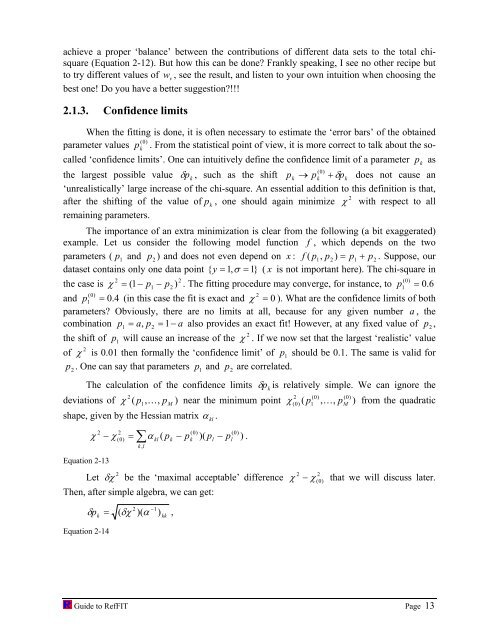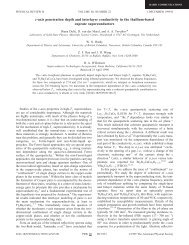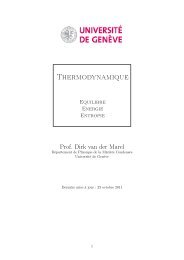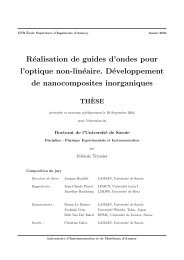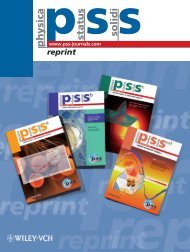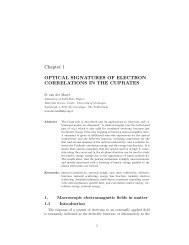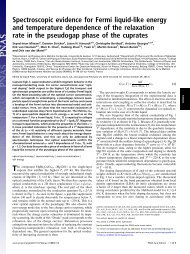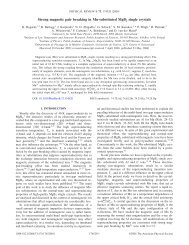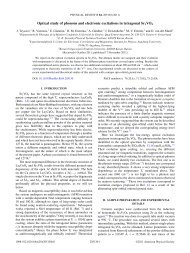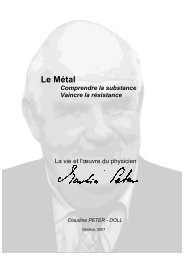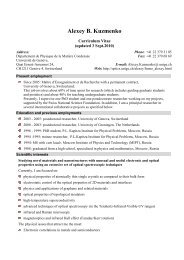software to fit optical spectra - Quantum Materials Group
software to fit optical spectra - Quantum Materials Group
software to fit optical spectra - Quantum Materials Group
Create successful ePaper yourself
Turn your PDF publications into a flip-book with our unique Google optimized e-Paper software.
achieve a proper ‘balance’ between the contributions of different data sets <strong>to</strong> the <strong>to</strong>tal chisquare<br />
(Equation 2-12). But how this can be done? Frankly speaking, I see no other recipe but<br />
<strong>to</strong> try different values of w v , see the result, and listen <strong>to</strong> your own intuition when choosing the<br />
best one! Do you have a better suggestion?!!!<br />
2.1.3. Confidence limits<br />
When the <strong>fit</strong>ting is done, it is often necessary <strong>to</strong> estimate the ‘error bars’ of the obtained<br />
( 0)<br />
parameter values p k . From the statistical point of view, it is more correct <strong>to</strong> talk about the socalled<br />
‘confidence limits’. One can intuitively define the confidence limit of a parameter p k as<br />
the largest possible value δ pk<br />
, such as the shift pk → pk<br />
+ δpk<br />
) 0 (<br />
does not cause an<br />
‘unrealistically’ large increase of the chi-square. An essential addition <strong>to</strong> this definition is that,<br />
after the shifting of the value of p k , one should again minimize 2<br />
χ with respect <strong>to</strong> all<br />
remaining parameters.<br />
The importance of an extra minimization is clear from the following (a bit exaggerated)<br />
example. Let us consider the following model function f , which depends on the two<br />
parameters ( 1 p and 2 p ) and does not even depend on x : f ( p1<br />
, p2<br />
) = p1<br />
+ p2<br />
. Suppose, our<br />
dataset contains only one data point { y = 1,<br />
σ = 1}<br />
( x is not important here). The chi-square in<br />
2<br />
2<br />
( 0)<br />
the case is χ = ( 1−<br />
p1 − p2<br />
) . The <strong>fit</strong>ting procedure may converge, for instance, <strong>to</strong> p 1 = 0.<br />
6<br />
( 0)<br />
2<br />
and p 1 = 0.<br />
4 (in this case the <strong>fit</strong> is exact and χ = 0 ). What are the confidence limits of both<br />
parameters? Obviously, there are no limits at all, because for any given number a , the<br />
combination p1 = a,<br />
p2<br />
= 1−<br />
a also provides an exact <strong>fit</strong>! However, at any fixed value of p 2 ,<br />
2<br />
the shift of p 1 will cause an increase of the χ . If we now set that the largest ‘realistic’ value<br />
2<br />
of χ is 0.01 then formally the ‘confidence limit’ of p 1 should be 0.1. The same is valid for<br />
p are correlated.<br />
p 2 . One can say that parameters 1 p and 2<br />
The calculation of the confidence limits δpk is relatively simple. We can ignore the<br />
2<br />
2 ( 0)<br />
( 0)<br />
deviations of χ ( p1, K,<br />
pM<br />
) near the minimum point χ ( 0)<br />
( p1 , K,<br />
pM<br />
) from the quadratic<br />
shape, given by the Hessian matrix α kl .<br />
2 2<br />
( 0)<br />
( 0)<br />
χ − χ ( 0)<br />
= ∑α kl ( pk<br />
− pk<br />
)( pl<br />
− pl<br />
) .<br />
Equation 2-13<br />
k , l<br />
Let<br />
Then, after simple algebra, we can get:<br />
k<br />
2<br />
δχ be the ‘maximal acceptable’ difference<br />
2 −1<br />
δ p = ( δχ )( α ) ,<br />
Equation 2-14<br />
kk<br />
2 2<br />
χ − χ ( 0)<br />
that we will discuss later.<br />
Guide <strong>to</strong> RefFIT Page 13


